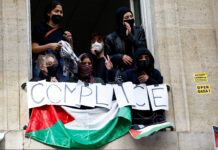This essay is a part of the COVID-19 dossier, edited by the b2o editorial staff.
by Anders Engberg-Pedersen
Within the past couple of months, war has emerged as the master metaphor of Covid-19. On March 16, President Emmanuel Macron, in an animated televised address to the French people, made “we are at war” into his refrain. Repeating the phrase no less than six times, he urged national support for the “battle” and moral support for the nurses on the “front line.” On March 17, across the Channel, Prime Minister Boris Johnson, before he himself contracted the virus, adopted the language of war during a press conference invoking the powers of a “wartime government.”
A day later, on March 18, President Donald Trump tweeted: “I want all Americans to understand: we are at war with an invisible enemy, but that enemy is no match for the spirit and resolve of the American people…” Steve Bannon, the former White House strategist, was quick to lend credence to the claim: “We are at war, and now by necessity he is a ‘wartime’ president.” Not one to miss a chance to play up his statesmanship, President Trump has since repeatedly cast himself in this role. Perhaps more surprisingly, leading Democrats have supported his line of thinking. Joe Biden has claimed that tackling the pandemic “is a national emergency akin to fighting a war” – thereby echoing Bernie Sanders’ statement that the crisis “is on a scale of a major war.”
Not only has it proven expedient for the political leadership to speak of Covid-19 in terms of war; under the heading “Economic Policies of the COVID-19 War,” the IMF issued a series of policy suggestions both for phase 1 – “the war” – and for phase 2 – “the post-war recovery.”[i] From Nobel-Prize winner in economics Joseph Stiglitz to leading US immunologist Anthony Fauci, there is general agreement that “this is a kind of war” and we are currently “living through the fog of war.”
If we turn to the media, the language of war is ubiquitous as well. “Invasions,” “attacks,” “defenses,” “mobilization,” “front lines,” “pandemic generals” etc. make up the preferred vocabulary in newspapers, in the radio, and on television. In short, across the board war has very quickly become the main trope for describing, understanding, and managing the Covid-19 pandemic. When George Lakoff and Mark Johnson published their book Metaphors we live by in 1980, one of their prime examples for an everyday metaphor was “argument is war.”[ii] By now, however, the “war on Covid-19” has been promulgated in so many ways that it has ceased to have much novelty as a metaphor. Within a few months, it has become a metaphor we live by.
Declaring war on concepts and natural phenomena is hardly new. In his State of the Union Address in 1964, Lyndon B. Johnson declared “unconditional war on poverty in America.” The following year, he began a “war against crime.” In the 1970s, Richard Nixon declared “war on cancer” along with a “war on crime” followed by Gerald Ford’s “war on inflation.” Obviously metaphorical, these linguistic military interventions mean something like a maximum collective effort to manage a significant large-scale problem. Hardly odious, we might think.
Yet, the pervasive militarization of language in the midst of the most serious health crisis in modern times should give us pause. For the reframing of a pandemic by the language of warfare is more than a useful rhetorical trick to convey the gravity of the situation and mobilize the populace. It also profoundly misrepresents the phenomenon that countries across the world are currently scrambling to control. And if we don’t extricate ourselves from the rhetoric of war, we will be stuck in a false metaphor that hinders our ability to think and act in the most expedient manner.
It wasn’t supposed to be like that. Long revered as the king of tropes, metaphor has a distinguished theoretical pedigree that expounds its crucial semantic and cognitive function. When Aristotle in the Poetics wrote that “to make metaphors well is to observe what is like something else,” he regarded metaphor not simply as a pretty linguistic embellishment or a slick rhetorical trick.[iii] He saw it as a source of genuine insight. When ordinary language comes up short, the well-wrought metaphor fills in the gap. A creative expression of language, metaphor articulates an insight that ordinary language cannot convey. What insights does the “war on Covid-19” offer, then?
The overlaps between the pandemic and war are obvious. Hospitals are flooded, doctors must perform triage, morgues and cemeteries are overwhelmed to the extent that mass graves are now being dug in New York City. The state of emergency has become a default governmental measure and the basic mechanics of societies has been profoundly disrupted. For a crisis of similar scale and gravity, the comparison that comes to mind is indeed war. Here is David Frum in The Atlantic assessing the number of Covid-19 deaths in the US: “By the end of March, the coronavirus had killed more Americans than the 9/11 attacks. By the first weekend in April, the virus had killed more Americans than any single battle of the Civil War. By Easter, it may have killed more Americans than the Korean War. On the present trajectory, it will kill, by late April, more Americans than Vietnam.”[iv] Indeed, in the scope, seriousness, and immediate impact on our lives, a global war would seem an apt metaphor for Covid-19.
Yet, speaking of a virus in terms of war comes with its own set of problems. In 1978 Susan Sontag published Illness as Metaphor. It is a wide-ranging book that traces the metaphors that have clustered around tuberculosis and cancer throughout the ages. But its main point is clear: illness is not a metaphor and metaphors do a great deal of damage both to the victims of tuberculosis and cancer and to our understanding of the illnesses themselves. Illness metaphors perform a radical simplification of complex etiologies and their redescriptions are anything but innocent. They carry moralistic meanings that ascribe blame to patients for contracting the illness or for not putting up enough of a fight to defend against the invasion and win the battle. Indeed, she writes, the most truthful way of regarding illness “is one most purified of, and most resistant to, metaphoric thinking.”[v]
In spite of the present popularity of the “war on Covid-19”-metaphor, the discrepancies are striking. In the current crisis, instead of mobilizing, people are demobilizing by sheltering in place; in spite of the invocation of the Defense Production Act of 1950 to ramp up production of masks and ventilators, general production has come to a screeching halt as workers are laid off; instead of secret intelligence gathering, there is widespread international cooperation and open sharing of information and statistics as countries test and implement effective measures to manage a common problem. All these key differences are glossed over every time the pandemic is articulated through martial metaphors.
A more serious problem with the metaphor, however, is the very image of war it evokes. The mental picture that it triggers in our brains involves something like a spectacular violent struggle between nations that takes place within clearly demarcated spatio-temporal boundaries giving rise to sacrifice, heroic exploits, and strong emotions. In the US and in Europe, much of this mental imagery dates back to WWII, which in the wider imagination has become synonymous with the “ideal war” – victorious, reasonably swift, with clear distinctions between good and evil, and, in the end, spectacularly decisive. In the past few weeks, Macron, Johnson, and Trump have all been trading on this imagery.
Yet, this image of war is thoroughly out of sync with the actual experience of war in the 21st century. Since 9/11, US foreign policy has been defined by global terrorism and the seemingly endless wars in Iraq, Afghanistan, and Syria. The Afghanistan Papers published by the Washington Post amply demonstrated the lack of vision, strategy, purpose, and progress that has characterized the past nearly two decades of American-led war. In Afghanistan, the US remains “trapped in the forever war,” in Mark Danner’s phrase.[vi] As retired US army colonel, Christopher D. Kolenda has put it, recent US military efforts can best be described as the painful performance of a “slow failure.”[vii] Rather than conjuring images of glorious battles and swift victories that mobilize the population, these distant, pointless, non-spectacular wars with weary allies and elusive enemies and aims have failed to deliver the powerful imagery and emotions of the “ideal war.” Instead, the effect has been first boredom and finally indifference in a population tired of war without end.
These are not the images and emotions that the war on Covid-19 are meant to activate. In the widespread use of martial metaphors today we might detect, therefore, a suppressed nostalgia. We long for the good old decisive war precisely because it does not fit the character of the pandemic. We declare war on the virus, because we want it to be something that it is not. The declaration of war, then, does not seek simply to describe our present situation. Rather, our daily feats of metaphorical magic function as speech acts that transform the epidemic into something more heimlich, something that we think we know and can relate to and that gives us comfort, something that used to be simple, manageable, and perhaps even heroic – war.
This metaphorical transformation solves another problem by alleviating a hidden anxiety. The fear of Covid-19 stems not least from the fact that it is non-intentional and non-human. The virus has no mind and no will. It has no strategy, it makes no demands, it lays claim to no territories, to no natural riches, to no economic advantages. As a purely natural phenomenon, Covid-19 causes illnesses that, as Susan Sontag argued, are fundamentally meaningless. No longer do we trace the etiology of the plague back to the wrath of the gods or any other metaphysical intentional being. Without malice, for no greater reason or overarching purpose, the virus has to date killed over 100,000 human beings.
Covid-19 thus confronts us with the frightening absence of meaning in nature. This is an uncomfortable fact that we would prefer not to think about. But by declaring war on the virus, we don’t have to. Transforming the virus into an enemy endows it with all the qualities of mind and intent that might give some meaning to what is otherwise a senseless loss of a staggering number of lives. The rhetoric of war – paradoxically – humanizes the virus by transforming it into a being on whom it is possible to wage war. Here the nostalgia for war results in a bizarre linguistic operation: the “war on Covid-19” locates meaning in the ability to mete out death, rather than in saving the lives of the population. And it recognizes nature only the moment it comes into focus as a target to be killed.
The transformation of a virus into an enemy to be vanquished by a long-lost dream of good old-fashioned warfare can do little but offer a false hope. In the scramble to control the pandemic, the actual, non-metaphorical US military has been virtually useless. The Navy hospital ship, USNS Comfort, succeeded, in spite of social distancing measures, in attracting a vast crowd when it sailed into New York Harbor in late March. After a week, however, due to administrative snafus, it had received only 20 patients. Meanwhile, Captain Brett Crozier, commanding officer of the aircraft carrier USS Theodore Roosevelt, was sacked following his request to offload the virus-stricken personnel for proper quarantine accommodations on land in Guam. As he pointedly wrote in a long letter to his superiors published by the San Francisco Chronicle: “We are not at war. Soldiers do not need to die.” Since then conditions have only worsened. In spite of the fact that the US boasts a national defense budget of app. 649 billion dollars (2019) – more than China, Saudi Arabia, India, France, Russia, the United Kingdom, and Germany combined – its military is powerless when it comes to handling Covid-19.
Shifting focus onto the imagined power of the US war machine, however, the rhetoric of war effectively directs public attention away from an inconvenient truth. When it comes to health care, life-span, access to education, security, infrastructure, the protection of minorities, and a fair distribution of wealth – all factors that determine the strength of the society to be defended – the US is lagging far behind other developed countries. Aside from the feeble attempt at grand statesmanship, President Trump’s self-fashioning as a wartime president serves to distract from the long history of misguided political priorities that make the current health crisis significantly more difficult to overcome for the US than it ought to be.
The solution to the Covid-19 pandemic is not a military one–neither metaphorically, nor actually. After nearly two decades of interminable war, the American mind needs to be demilitarized. The first step is to abandon the rhetoric of war that has such a powerful grip on the political imaginary. The language of the future is not the reductive language of human aggression and destruction, but the language of protection, of caring, curing, nurturing, developing, organizing, cooperating, and building. Not war, but care could be the master metaphor for the coming decade. But as long as presidents, prime ministers, and the media keep framing the pandemic in military terms, we will all have to contend not merely with the worst health crisis in modern memory, but also with a powerful, false metaphor that clouds the mind and hinders appropriate action.
Anders Engberg-Pedersen is Professor of Comparative Literature and an affiliate of the Center for War Studies at the University of Southern Denmark. He is the author of Empire of Chance. The Napoleonic Wars and the Disorder of Things (Harvard University Press, 2015), editor of Literature and Cartography: Theories, Histories, Genres (MIT Press, 2017), The Humanities in the World (U Press, forthcoming 2020), and co-editor of Visualizing War. Emotions, Technologies, Communities (Routledge, 2018). He serves as general editor of the book series Prisms: Humanities and War with MIT Press and as co-editor of the podcast series War and Representation at Oxford University. He is currently directing the collective research project The Aesthetics of Late Modern War sponsored by the Carlsberg Foundation and the Velux Foundations.
[i] Giovanni Dell’Ariccia, Paolo Mauro, Antonio Spilimbergo, and Jeromin Zettelmeyer “Economic Policies for the COVID-19 War”. IMFBlog, 1 April, 2020: https://blogs.imf.org/2020/04/01/economic-policies-for-the-covid-19-war/
[ii] George Lakoff and Mark Johnson, Metaphors we live by: Chicago: The University of Chicago Press, 2003, p. 4-6.
[iii] Aristotle, Poetics. Indianapolis: Hackett Publishing Company, 1987, p. 32.
[iv] David Frum “This is Trump’s Fault”. 7 April, 2020: https://www.theatlantic.com/ideas/archive/2020/04/americans-are-paying-the-price-for-trumps-failures/609532/
[v] Susan Sontag, Illness as Metaphor. New York: Farrar, Straus and Giroux, 1978, p. 3.
[vi] Mark Danner, Spiral. Trapped in the Forever War. New York: Simon & Schuster, 2016.
[vii] Christopher D. Kolenda, “Slow failure: Understanding America’s quagmire in Afghanistan”. Journal of Strategic Studies, 42/7, 2019: https://www.tandfonline.com/doi/abs/10.1080/01402390.2019.1663179




